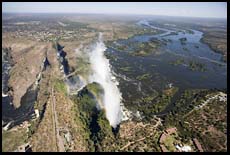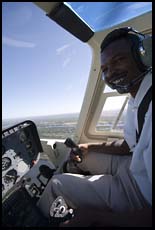
A Photographer's Guide to Victoria Falls
by Philip Greenspun; created June 2007
Victoria Falls is one of the wonders of the natural world and yet among the world's most difficult photographic subjects.
The Falls are about one mile (1.7 km) wide and 300' (100m) high, dumping the Zambezi River into a crack in the Earth created by the same plates whose pulling apart has created the Great Rift Valley. The Falls are oriented west-to-east, with the water coming from the north and spilling down to the south. This is in the Southern Hemisphere, which means that the sun is to the north for most of the day, providing unwelcome backlight. Even worse, you can't stand at the bottom of the falls, which is a spray-filled gorge. Most waterfalls spill from high ground to low ground. The downstream side of Victoria Falls is in fact just about as high as the upstream side. The view from the ground, especially during the high water season (March through May), is mostly of spray that obscures the falls themselves and will drench your camera.
Keeping your camera underneath a rain poncho should generally be sufficient for protection from the spray, but if you want to attempt some pictures from spots that are being intermittently drenched, a "rain cover" or "rain cape" is a good idea. These are what TV crews use to protect their camcorders and they are available from Tenba and Ewa-Marine for still cameras. Focal lengths between 24mm and 50mm are most useful for walking around on the trails.
For drama, the end of the wet season (April/May) offers water spraying up more than 1000' into the air. For capturing the structure of the falls, it is better to wait until July or August when the flow slows down to the point that rocks and individual streams are visible from the downstream side.
There are rainbows over the Falls at most times of day. The park is open for night-time walks during the full moon, good for catching a consistent lunar rainbow. Bring a polarizing filter (I was traveling light, so none of the photos in this article were taken with one) to intensify the rainbow.

The best, and maybe the only, way to appreciate the structure of the Falls is from the air. Helicopter Tours are offered from both Zambia and Zimbabwe. These photos were taken from the Zimbabwean side, Shearwater Adventures, which operates Bell Jet Rangers. The front seat is good if you want photos of the pilot at the controls (a fill-flash would have helped equalize the light here). The back seat offers a larger photo door.
The aerial photos on this page were taken at focal lengths ranging from 16-50mm on a full-frame digital SLR.
Safety tips: Try not to walk into the spinning tail rotor while entering or exiting the helicopter. A good strategy for walking around spinning helicopters is to maintain eye contact with the pilot. If you can see the pilot, you can't be back at the tail rotor. Especially if you are sitting on the left side, ensure that your lens hood is very securely attached and does not fly out and hit the tail rotor. The hood is probably not heavy enough to bring the helicopter out of the sky, but it will cause $10,000 in damage.
Safety fears: Helicopters are not as safe per hour as airliners, but sightseeing around Victoria Falls is probably one of the safest and easiest types of helicopter operation. You won't be going at night or in bad weather. Insurance and the machines are very expensive, so the pilots tend to be experienced even though the actual flying could be done by a student pilot.
The Victoria Falls Aquarium on the Zimbabwean side is a comprehensive introduction to the Zambezi river system, with natural tanks holding most of the fish from above and below the Falls. Not a great photo opportunity, but educational and good if you're a home aquarium lover.
Any packaged tour will put you on a sunset cruise. A 70-200 zoom lens makes sense as a starting point for equipment on the boat. You'll see elephants and hippos in the margins of the river. You'll drink some Zimbabwean wine and discover why it is not a competitive export. Don't stay sober in hopes of an award-winning photo.
Victoria Falls is a good starting point for driving safaris into the national parks of Botswana, eastern Namibia, Zambia, and Zimbabwe. The places you can visit as day trips, however, tend to be clogged with tourists and not representative of the best African experience. For advice on the best nearby places for photographers, contact James Weis at Eyes on Africa, and let him book you with some reliable local tour operators.
This is a summary of equipment recommended elsewhere in the article...
The big decision is Zambia versus Zimbabwe. Given the collapse of the Zimbabwean economy, you'd think that this would be an easy one: Zambia. In May 2007, Zimbabwe was elected chairman of the United Nations Commission on Sustainable Development. Success in New York hasn't translated into an easy life for the average Zimbabwean circa 2007. The gas stations ran out of gas two years ago. Food and clothing are becoming more scarce and expensive. Several million people have emigrated to neighboring countries in search of jobs. Remarkably, however, the tourist industry in Zimbabwe continues to operate more or less seamlessly. Boeing 737s from Jo'burg to VFA operate as scheduled. Jet fuel is trucked in for the sightseeing helicopter. Tourist minibuses get filled up with black market gasoline (not too much more per gallon than Californians pay at the pump).
Staying in Zimbabwe has some advantages. This is the side from which the falls are best appreciated. This is the side where more tourist infrastructure has been built up over time.
We stayed in the classic hotel in the area: the Victoria Falls Hotel, on the Zimbabwean side. Service was impeccable. This is a 10-minute walk to the Falls, though you might have to detour around browsing elephants. Decor is old colonial; rooms are very comfortable.
The fanciest hotels on the Zambian side are the Royal Livingston and Zambezi Sun. We talked to some people who had stayed at the Royal Livingston and thought that it was a bad value.
Iguazu Falls on the border between Argentina and Brazil is another high-volume waterfall in the middle of a jungle. Iguazu is much easier to photograph because the downstream side is lower than the falls and there are walkways on top of the falls.
Niagara Falls if you can handle the rugged raw wilderness...
Text and pictures copyright 2007 Philip Greenspun
The Vic Falls photos were taken with a